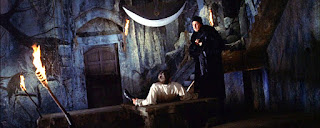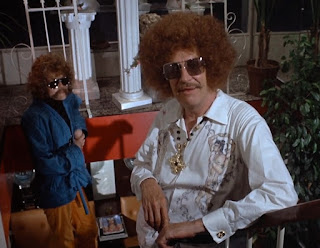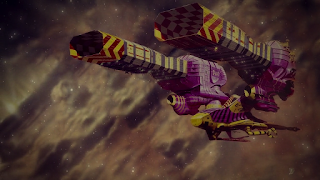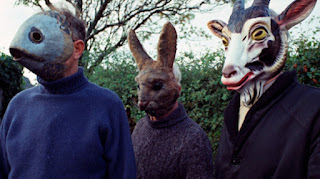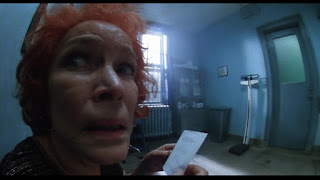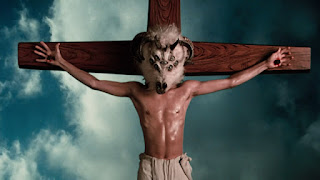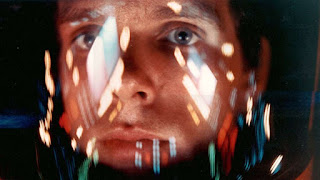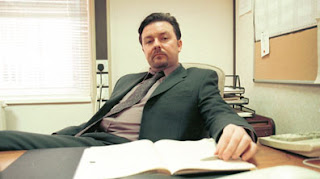The late, great Vincent Price was many things: an actor, a chef, a patron of the arts, a strong supporter of the LGBTQ+ community, and above all a horror legend through and through. Prices career was defined by his roles in countless horror films over the years, making him one of the most prolific faces of the genre even after his death. I'm a huge Vincent Price fan, so in honor of what would have been his 107th birthday, here are ten of his essential films.
10. Tales of Terror (Roger Corman, 1962)
This anthology film borrowing from the works of Edgar Allan Poe saw Price take on three different roles, one for each segment. From a depressed widower, to a sophisticated wine connoisseur, and finally an elderly man dying from a fatal disease, Price displays his range of acting abilities here in each different role. His portrayal of Fortunato Luchresi in the 'Black Cat' segment is the true highlight however, with Price putting that ever expressive face of his to use during a rather comedic wine tasting scene. With its gothic imagery and darkly comedic tone, Tales of Terror is an entertaining watch and a fine example of Prices range as an actor as well.
9. Madhouse (Jim Clark, 1974)
By the time Mad House was released Price was already a highly established horror icon, and this British horror film acts as a tribute of sorts to his extensive career. Here, Price plays horror actor Paul Toombes, best known for playing the villainous Dr. Death onscreen. However Toombes becomes convinced that his sanity is slipping when he becomes linked to a string of grizzly murders, believing that Dr. Death is to blame. The film uses archive footage from a variety of Prices earlier pictures and takes a somewhat meta approach to both his career and the horror genre itself. There's even a scene where he goes for an interview with Michael Parkinson, playing himself of course. As well as that, fellow horror icon and Prices longtime friend Peter Cushing co-stars as Toombes' screenwriter friend Herbert Flay. While it's not often considered Prices best film, I think it's a fitting tribute to the actors colourful career and a must see for fans of his.
8. The Raven (Roger Corman, 1963)
Another of the many Edgar Allan Poe adaptations starring Price and directed by Roger Corman, The Raven expands upon Poe's iconic poem in the most bizarre way possible. Price takes on the role of Dr. Erasmus Craven, a sorcerer who encounters a man transformed into the titular bird (played by Peter Lorre). Craven and Dr. Bedlo (Lorre) then join forces to defeat the evil wizard Dr. Scarabus (Boris Karloff) who transformed Bedlo into a raven in the first place. This is a true clash of the horror titans, with Peter Lorre and an elderly Boris Karloff starring alongside Price, along with a young Jack Nicholson. It's a bonkers film altogether, culminating in an epic wizard duel between Price and Karloff's characters, and while it lacks the moodiness of its source material it's certainly an entertaining entry into Prices filmography. The wizard duel makes it all worth it, trust me.
7. House on Haunted Hill (William Castle, 1959)
In this William Castle classic Price plays eccentric millionaire Frederick Loren, who invites a group of people to stay in a supposedly haunted house while offering $10,000 to anyone who lasts the entire night. This moody piece of late 50's horror cinema plays out like a cross between a classic ghost story and an Agatha Christie mystery. It begins as a haunted house-type situation but soon develops into something much more interesting, keeping the audience guessing whether the house is actually haunted or not. Price is on full form here and appears to have a lot of fun in the role of Frederick Loren, especially during some of his later scenes when the plot begins to unravel. When House on Haunted Hill was eventually remade 40 years later, the millionaire character (now played by Geoffrey Rush) was renamed Stephen Price, and his appearance was even modeled after Vincent Price himself. A fitting tribute to the star of the original film.
6. House of Wax (Andre DeToth, 1953)
While this wasn't Prices first horror picture, it was arguably the one that established him as a master of the macabre for the rest of his career. In this remake of Mystery of the Wax Museum, Price plays Professor Henry Jarrod, the proprietor of a wax museum full of hyper-realistic sculptures. Of course, it doesn't take a genius to understand what's really going on, but it's incredibly fun to see how it all plays out. Price manages to bring a strange sense of pathos to the sinister Professor Jarrod, while succeeding in bringing out his eerie and imposing side at the same time. The final revelation of Jarrod's true face remains one of horror cinema's most iconic moments, in a career-defining film for Vincent Price. After House of Wax, Prices career in the horror genre would really kick off before fully flourishing in the following two decades.
5. The Pit and the Pendulum (Roger Corman, 1961)
Yet another Price/Corman collab working off an Edgar Allan Poe story, Pit follows the ghoulish series of events that take place within a Spanish castle once used by the inquisition. Price takes on the role of Nicholas Medina, the troubled owner of the castle who recently lost his wife. As well as that, he also suffered an earlier childhood trauma when he witnessed his father use inquisitorial torture devices on his mother and uncle. Price is initially more reserved than usual in the role, and he convincingly portrays the grieving and troubled Nicholas. However, in the films final act after things take a massive twist, he reverts to a much more sinister state and has a lot of fun with the role from thereon. When it finally reaches the climax involving the titular pit and pendulum, Price shines through as always.
4. The Masque of the Red Death (Roger Corman, 1964)
Arguably the best of Price's collaborations with Roger Corman, The Masque of the Red Death expands upon Edgar Allan Poe's original story about a deadly plague spreading across a medieval land. Price takes on the role of the tyrannical Prince Prospero, a satanist who resides in a massive castle along with members of the nobility and several prisoners. The film is an incredibly surreal experience in comparison to some of Corman's other Poe adaptations, and the final scenes in particular play out like some sort of nightmarish fever dream. Price is darkly comical as the sadistic Prince Prospero, managing to bring some of his trademark campy qualities to the villainous royal. He's the type of villain you love to hate, and he certainly gets what's coming to him when he comes face to face with the eponymous red death. Fun fact as well: The director of photography on this film was Nicolas Roeg, who would go onto direct Don't Look Now around a decade later. He must have a thing for red hoods.
3. Witchfinder General (Michael Reeves, 1968)
While Price was no stranger to playing the villain, they were usually darkly comical or campy at least, however, Matthew Hopkins is neither of those things. A real life witch hunter in Cromwellian England, Hopkins was brought to life by Price for this classic British folk horror, and he is arguably his most sadistic role to date. Spending the duration of the film torturing women and putting them to death, Prices Hopkins is not a man to be trifled with. He is a stern and sadistic villain who appears to take great pleasure in torturing innocent women, under the pretense of them being witches. While Price was always sinister when he played the villain, this was a new level of evil altogether and is something of a refreshing performance from him. The fact that Hopkins was also a real life figure makes it all the more unsettling as well.
2. The Abominable Dr. Phibes (Robert Fuest, 1971)
Onto a more lighthearted antagonist now, Dr. Phibes is arguably one of Price's most iconic characters, even gaining himself a sequel the following year. In this darkly-comical horror, Dr. Anton Phibes sets out to take revenge on the surgeons who failed to save his wife after a fatal car accident. He slowly picks off each of his victims one by one, basing each murder on one of the ten plagues of Egypt. Colourful, campy, and macabre, Dr. Phibes is a definitive Price film. From its art-deco sets, to its inventive murder sequences and its overall tongue-in-cheek attitude, the film is widely enjoyable and incredibly unique in both its visuals and story. Phibes is perhaps the strangest character that Price has ever brought to life, using a gramophone-type device plugged into his neck in order to speak, and amusing himself with his bizarre clockwork band. Price is at his best here, and you can tell he loved every minute of it.
1. Theater of Blood (Douglas Hickox, 1973)
Vincent Price had always expressed interest in doing Shakespeare, but his association with the horror genre left him typecast as more of a horror villain. Theatre of Blood however, allowed Price to fulfill his dream of performing Shakespeare, as he takes on the role of vengeful actor Edward Lionheart. In a similar formula to Phibes, this film sees Lionheart murdering several theater critics who humiliated him two years beforehand. Each murder is based on an event from one of Shakespeare's plays, while Lionheart recites a quotation from the bard during each of them. It's a bizarre film but strangely captivating, and Price is particularly impressive in his role as Edward Lionheart. As always however, it doesn't take itself too seriously and allows Price to have a lot of fun with each death scene in particular. For example, there's one moment where he dons a fake afro and disco garments to disguise himself before one of the murders, it's arguably one of the strangest, yet most hilarious scenes I've ever witnessed in a horror film. Theater of Blood is the definitive Vincent Price film as it allows him to really stretch his acting chops to their fullest extent. If you're a horror fan, or even just a Shakespeare fan, then it's definitely a must watch.






